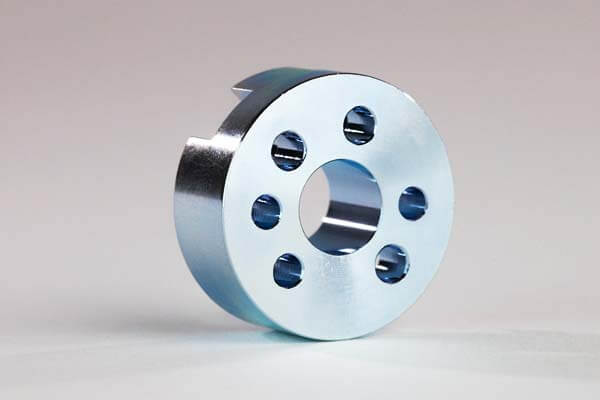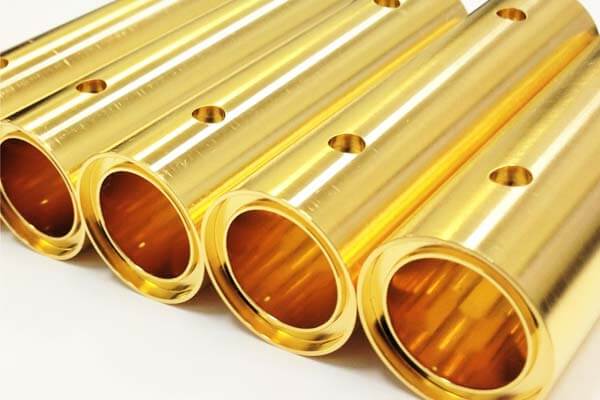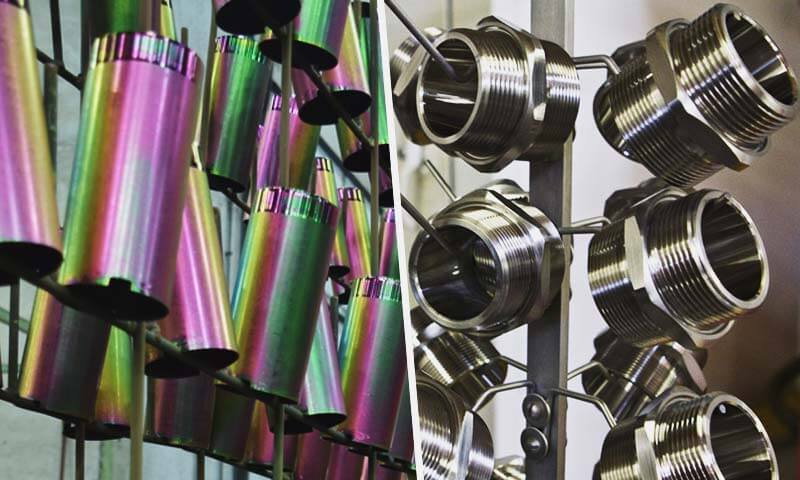When considering the ideal plating method for your project, understanding the strengths and limitations of each available option is crucial.
Zinc plating and nickel plating are two of the most frequently employed techniques to improve the characteristics of metal components.
These two plating methods come with distinct advantages depending on factors like corrosion resistance, aesthetic appeal, and cost.
This blog post delves into the specifics of both plating options, analyzing their features, advantages, and the situations in which each excels.
1. What is Zinc Plating?
Zinc plating, also known as galvanizing, is a widely applied electroplating technique in which a thin layer of zinc is deposited onto metal parts, typically steel or iron.
This process serves to enhance the material’s resistance to corrosion, protecting the underlying metal from rusting and degradation due to exposure to environmental factors.
Zinc acts as a sacrificial anode in this process, meaning it will corrode first, effectively safeguarding the base metal.

How Zinc Plating Works
The process of zinc plating involves several key stages:
- Surface Preparation: Initially, the metal object is cleaned thoroughly to remove oils, grease, dirt, and any rust. This ensures the zinc adheres properly to the substrate.
- Electroplating: The prepared substrate is submerged in a zinc electrolyte solution containing zinc salts and water.
An electrical current is applied, causing zinc ions to reduce and form a thin protective layer on the metal’s surface. - Passivation: After the plating process, the zinc-coated object may undergo passivation,
where it’s treated with a chromate solution or similar chemicals to provide an additional layer of protection
and sometimes a variety of finishes, like blue, yellow, or clear, for aesthetic purposes. - Drying: Lastly, the plated object is dried, solidifying the protective finish and enhancing its durability.
Key Features of Zinc Plating
- Corrosion Resistance: Zinc plating is highly effective in preventing rust, especially in environments with moisture, salt, and chemicals.
The zinc layer forms a protective barrier that stops the base metal from corroding. - Sacrificial Protection: Zinc offers galvanic corrosion protection, meaning if the coating is damaged, the zinc will corrode in place of the base metal, continuing to protect it.
- Cost-Effectiveness: Zinc plating is an affordable process, especially when compared to nickel plating or other coatings, making it a go-to option for large-scale production.
- Electrical Conductivity: Zinc-plated surfaces maintain good electrical conductivity, suitable for applications requiring the flow of electricity.
Benefits of Zinc Plating
- Long-Lasting Protection: Zinc’s sacrificial nature guarantees extended corrosion protection, especially in wet or salt-rich environments, such as coastal or industrial areas.
- Affordable: Zinc is a budget-friendly material, and the process itself is quick and inexpensive, making it ideal for industries needing cost-effective metal protection.
- Maintenance-Friendly: Zinc coatings can be easily touched up with galvanizing sprays if damage occurs, which prolongs the life of the plating.
- Versatile Applications: Zinc plating can be used on a wide range of metals, including fasteners, automotive parts, and structural components.
Limitations of Zinc Plating
- Wear Resistance: Zinc is softer than some other coatings, like nickel, making it less suitable for high-wear applications. It may degrade more quickly in high-stress environments.
- Appearance: The finish of zinc plating is typically matte or dull, which may not be suitable for applications requiring a shiny or decorative look.
Although passivation can improve the appearance, it remains less aesthetically appealing than nickel plating. - Limited Durability in Harsh Environments: While effective in many environments, zinc plating is not ideal for extremely aggressive settings involving high temperatures or harsh chemicals.
Nickel or chrome plating might be better suited for such applications.
2. What is Nickel Plating?
Nickel plating is an electroplating process in which a thin layer of nickel is deposited onto a substrate, usually metal.
Nickel plating provides a combination of protection, aesthetics, and performance, making it a popular choice in a wide variety of industries.
The plating enhances corrosion resistance, wear resistance, and surface appearance.

How Nickel Plating Works
The nickel plating process includes these steps:
- Surface Preparation: As with zinc plating, the metal substrate must first be thoroughly cleaned. The surface is degreased, cleaned of rust, and sometimes pickled to remove oxides.
- Electroplating: Once the substrate is prepped, it’s submerged in a nickel electrolyte solution, and an electrical current is applied.
Nickel ions are reduced and deposited onto the substrate to form a uniform layer. - Brightening and Finishing: Depending on the desired appearance, brightening agents can be added to the solution to achieve a glossy, shiny finish.
Nickel plating can also be applied in varying thicknesses based on the application requirements. - Post-Treatment: Depending on the application, the plated item may undergo further treatments to improve corrosion resistance or enhance the finish,
such as chromate conversion coatings.
Key Features of Nickel Plating
- Corrosion Resistance: Nickel is naturally resistant to oxidation, and the plating process amplifies its ability to withstand moisture, acids, and chemicals, providing superior corrosion protection.
- Wear Resistance: Nickel plating enhances the hardness of the coated material, making it ideal for high-friction or high-stress applications such as gears, pistons, and machinery parts.
- Aesthetic Appeal: The lustrous finish of nickel plating is one of its most attractive features, providing a shiny, polished, or satin finish that is ideal for decorative products.
- Electrical Conductivity: Nickel offers good electrical conductivity, making it suitable for electrical connectors, contacts, and circuit boards.
Benefits of Nickel Plating
- Superior Durability: Nickel plating is known for improving hardness and wear resistance, ensuring that the coated object can endure extreme conditions without degrading.
- Long-Term Protection: The durable and long-lasting barrier against corrosion that nickel provides is ideal for parts exposed to harsh operating conditions,
such as in aerospace or automotive industries. - Aesthetic Value: The polished, high-end appearance of nickel plating makes it a preferred choice for decorative items in the consumer goods industry.
- Increased Longevity: Due to its corrosion resistance and wear properties, nickel plating can significantly increase the lifespan of components,
particularly those exposed to harsh conditions.
Limitations of Nickel Plating
- Higher Cost: Nickel plating is more expensive than zinc plating due to the higher cost of nickel and the more complex plating process. This could impact projects on a tight budget.
- Hydrogen Embrittlement: Nickel plating can sometimes lead to hydrogen embrittlement, where hydrogen gas is absorbed during plating, causing the substrate to weaken.
This is especially problematic for high-strength steel. - Environmental Concerns: Nickel is a heavier metal, and the plating process can generate hazardous waste. Proper waste management is crucial to minimize the environmental impact.
3. Zinc Plating vs Nickel Plating: Key Differences
| Feature | Zinc Plating | Nickel Plating |
|---|---|---|
| Corrosion Resistance | Offers good corrosion resistance, especially in outdoor, industrial, and marine environments. Zinc acts as a sacrificial anode, corroding first to protect the base metal. |
Provides superior corrosion resistance, especially in harsh conditions like exposure to acids, chemicals, and high humidity. However, it doesn’t offer sacrificial protection. |
| Wear Resistance | Lower wear resistance compared to nickel plating. Suitable for applications with moderate wear. | Excellent wear resistance, making it ideal for high-abrasion environments and parts subjected to heavy friction or mechanical stress. |
| Aesthetic Appearance | Matte or dull finish, though it can be passivated for a brighter or colored appearance (yellow, clear, blue). | A glossy, lustrous finish, often polished to a high shine, ideal for decorative applications. |
| Cost | Cost-effective and widely used due to the relatively low cost of zinc and the simplicity of the plating process. | More expensive than zinc plating due to higher material costs (nickel) and a more complex plating process. |
| Hardness | Softer compared to nickel plating, which makes it less ideal for high-stress or abrasive applications. | Harder than zinc plating, offering better protection against abrasion and wear. |
| Electrical Conductivity | Good electrical conductivity, making it suitable for electrical components where current flow is needed. | Also offers good electrical conductivity but excels in high-performance electrical applications, such as connectors and circuit boards. |
| Environmental Impact | More environmentally friendly due to the abundance and recyclability of zinc. Minimal hazardous waste. | Nickel plating can produce hazardous waste and requires careful disposal, making it less environmentally friendly than zinc. |
| Durability | Adequate durability for many industrial applications but may wear off more quickly under high-stress or abrasive conditions. | Superior durability, particularly in tough conditions, leads to longer service life for components exposed to extreme environments. |
| Recyclability | Zinc is highly recyclable, making it a more sustainable option in terms of environmental impact. | Nickel is less environmentally friendly in terms of recycling due to the more complex process involved in its plating. |
| Best Use Cases | Automotive parts, construction materials, electrical components, and fasteners are exposed to moderate conditions. | Aerospace, automotive, and electrical components require high wear resistance, and decorative products, and components are exposed to aggressive chemicals. |
4. Choosing the Right Plating for Your Project
When deciding between zinc and nickel plating for your project,
it’s crucial to consider a variety of factors that will influence the long-term performance, aesthetics, and cost-efficiency of the components.
Both plating options offer distinct benefits, and the best choice depends on the specific requirements of your application.
Here’s a breakdown of the primary factors to consider when choosing the right plating:
Environmental Exposure and Corrosion Resistance
- Zinc Plating: If your components will be exposed to moderate environmental conditions,
such as humidity, moisture, or salt (common in automotive, construction, and marine applications), zinc plating is an excellent choice.
The sacrificial nature of zinc provides reliable corrosion protection by corroding first, thereby protecting the base material.
Zinc plating is particularly effective in outdoor and industrial applications where corrosion resistance is a priority. - Nickel Plating: Nickel plating, on the other hand, offers superior corrosion resistance in more aggressive environments, such as exposure to chemicals, acids, or extreme humidity.
It provides a more robust barrier against corrosion than zinc,
making it ideal for applications like aerospace, heavy machinery, or components exposed to high-stress chemical environments.
Wear Resistance and Durability
- Zinc Plating: While zinc plating offers adequate durability in less abrasive environments, it is softer compared to nickel plating.
As such, it may wear down more quickly under conditions involving high friction or mechanical stress.
This makes zinc plating more suitable for components that don’t experience heavy abrasion, such as fasteners, bolts, and structural components. - Nickel Plating: If wear resistance and long-term durability are crucial to your project, nickel plating is the preferred option.
The hardness of nickel plating helps protect components from abrasion and wear, making it the ideal choice for parts exposed to high friction, such as gears, pistons, and valves.
Aesthetic Requirements
- Zinc Plating: Zinc offers a matte or dull finish, which may not be suitable for decorative applications where appearance is key.
However, zinc plating can be passivated to enhance its aesthetic appeal, achieving different colors like yellow or clear, and offering a more appealing finish for industrial parts. - Nickel Plating: Nickel plating shines with its glossy, lustrous finish, making it the ideal option for products that need both durability and aesthetic appeal.
Its polished, premium appearance makes it perfect for decorative applications like jewelry, consumer electronics, and high-end automotive parts.
Cost Considerations
- Zinc Plating: If cost is a primary concern, zinc plating is the more affordable option.
Zinc is a relatively inexpensive material, and the plating process is simpler, making it an ideal solution for large-scale production where cost efficiency is a priority.
It’s an excellent choice for projects with tight budgets or when only moderate wear protection is needed. - Nickel Plating: Nickel plating comes at a higher cost due to the more expensive material and complex electroplating process.
However, this investment can be worthwhile for applications requiring superior durability, wear resistance, and corrosion protection.
If your project demands premium performance, the additional cost of nickel plating is justified by its enhanced properties.
Electrical Conductivity and Performance
- Zinc Plating: Zinc provides good electrical conductivity, which makes it suitable for applications where electrical current needs to flow,
such as electrical components and connectors. However, its conductivity is not as high as that of nickel. - Nickel Plating: Nickel plating also offers good electrical conductivity, but its superior durability and corrosion resistance
make it the better choice for high-performance electrical applications, such as connectors in high-voltage or high-performance electronic devices.
Recyclability and Environmental Impact
- Zinc Plating: Zinc is an environmentally friendly option due to its recyclability and low environmental impact during the plating process.
If sustainability is a key factor in your decision, zinc plating is a more eco-conscious choice compared to nickel. - Nickel Plating: Nickel is more challenging to recycle and can have a higher environmental impact due to the hazardous waste generated during the plating process.
It’s important to consider disposal and waste management when opting for nickel plating.
Best Use Cases for Each Plating
- Zinc Plating: If your project involves cost-effective protection against corrosion for components exposed to mild environments, zinc plating is the right choice.
It’s commonly used in industries like automotive (e.g., fasteners, brackets, and bolts), construction (e.g., structural fasteners, nuts, and bolts),
and general industrial applications where moderate wear resistance is sufficient. - Nickel Plating: Choose nickel plating when your project requires high wear resistance, superior corrosion protection, and a high-quality finish.
It’s widely used in industries like aerospace (e.g., engine components, turbine blades), heavy machinery (e.g., gears, pistons),
and consumer goods (e.g., jewelry, automotive trim) where both performance and appearance are critical.
5. Conclusion
Both zinc and nickel plating offer distinct advantages, and selecting the best option requires considering factors such as the environment, mechanical stress, aesthetics, and budget.
Zinc plating excels in cost-effective corrosion protection for industrial applications, while nickel plating stands out for its superior durability, wear resistance, and premium appearance.
By assessing the specific needs of your project, you can choose the most suitable plating method to optimize performance and longevity.
6. How DEZE Can Support Your Needs
At DEZE, we specialize in custom metal finishing solutions, including zinc and nickel plating.
Whether you need corrosion protection, wear resistance, or aesthetic enhancement, our team can help you select the right plating process for your needs.
Contact us today for personalized advice and high-quality plating services tailored to your specific requirements.
7. Frequently Asked Questions (FAQs)
How long does zinc plating last?
Zinc plating can last anywhere from several months to several years, depending on environmental conditions and maintenance practices.
Can nickel plating be used for decorative purposes?
Yes, nickel plating is highly valued for its lustrous, shiny finish and is commonly used in decorative applications like jewelry and consumer electronics.
Which plating is better for electrical components?
While both zinc and nickel plating offer electrical conductivity, nickel plating is generally preferred for high-performance electrical components due to its superior durability and corrosion resistance.
How do I repair zinc plating?
Zinc plating can be easily repaired by reapplying a fresh layer or using touch-up products like spray-on galvanizing to restore corrosion protection.


